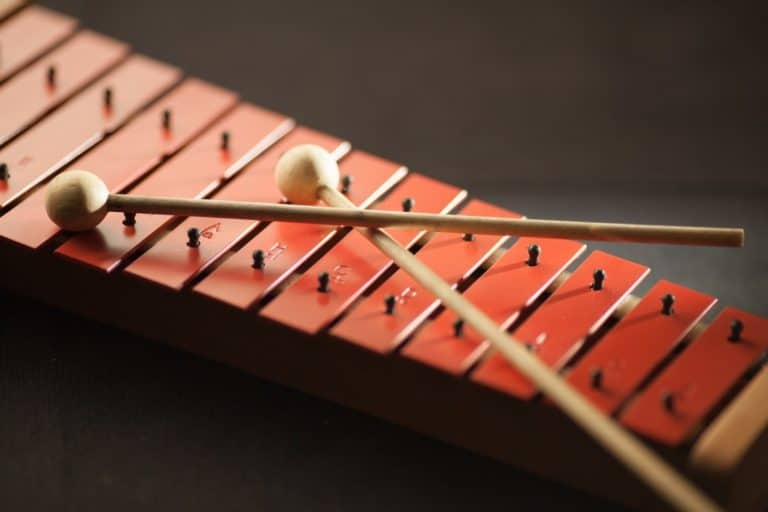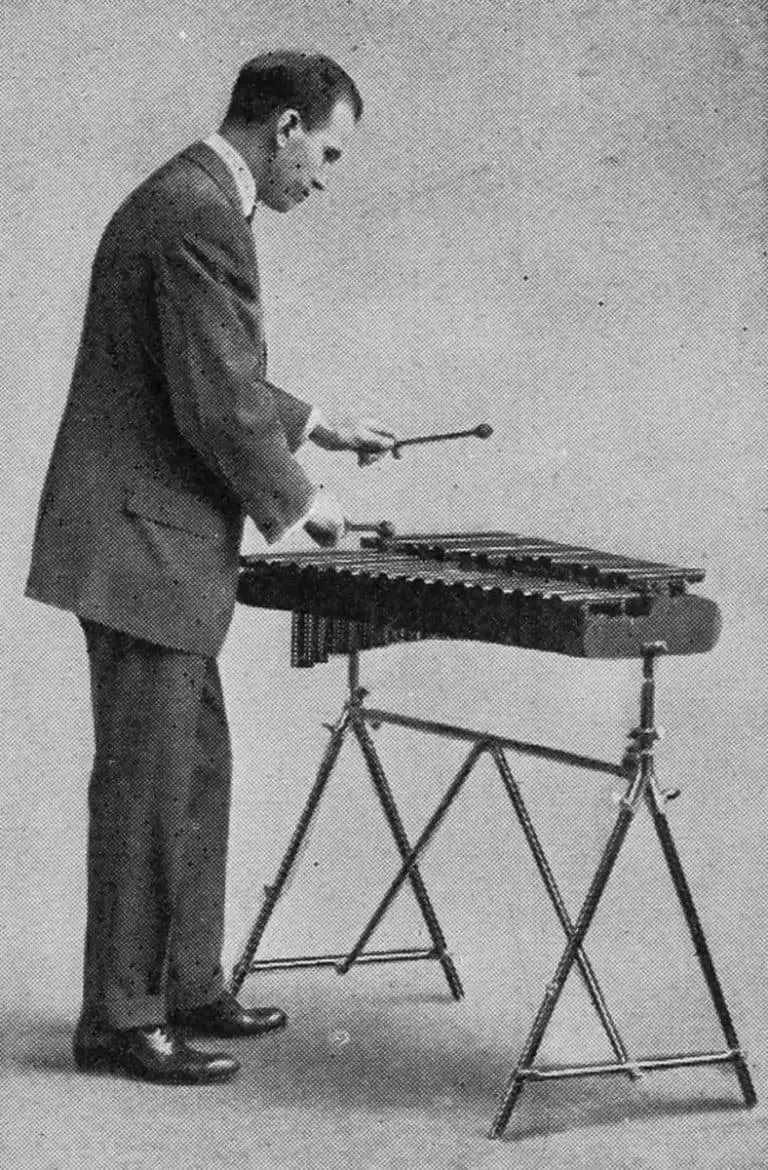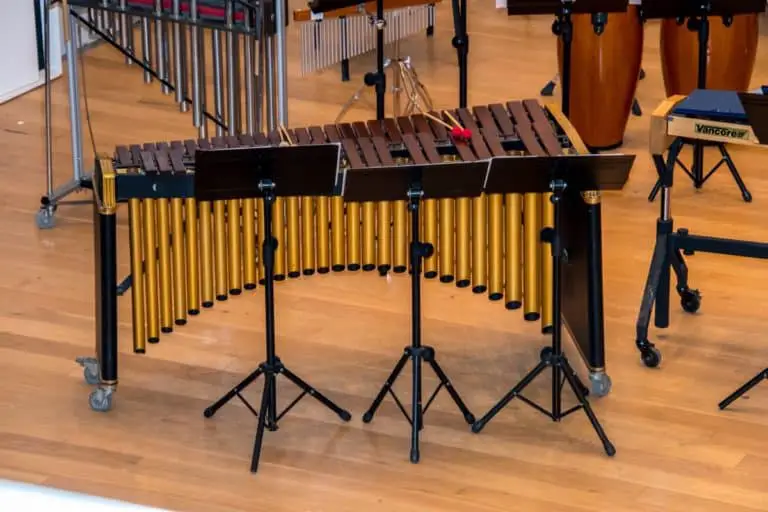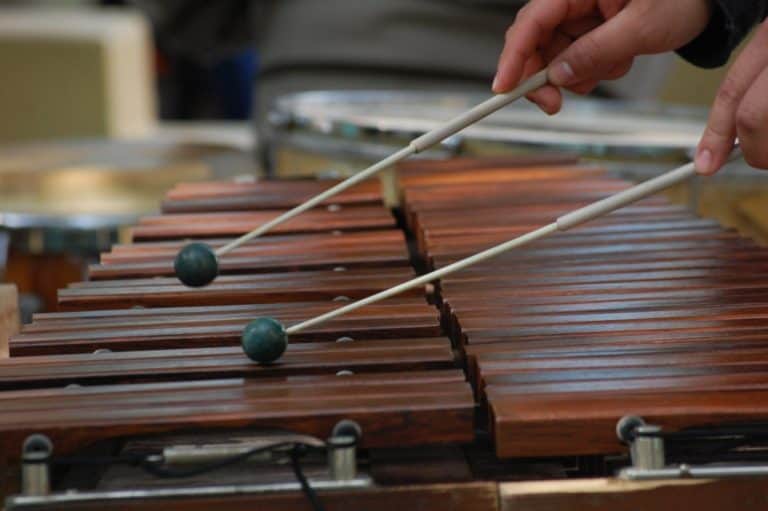Before you Buy Mallets for the Glockenspiel
There’s a very varied assortment of mallets for your glockenspiel and that brings us to our next question: What are the best kinds? Let’s take a look and find out!
What are the best mallets for glockenspiel? – The James Ross Signature range from Innovative Percussion features small hard heads for bright sound and cutting articulation on rattan shafts. Ideal when wanting to play Holst’s The Planets or Khachaturian’s Sabre Dance
Read on to find out the best mallets for glockenspiel in a range of situations
List of Best Mallets for Glockenspiel
- James Ross Signature
- American Drum Rubber [Price on Amazon]
- Shappy Bell Mallets Glockenspiel [Price on Amazon]
Best professional
Innovative Percussion James Ross Signature
Innovative percussion produce quality mallets and there is no exception when it comes to these James Ross Signature glockenspiel mallets! Offering great quality you can also expect
- Brilliant Bright Synthetic Heads
- Durable, Flexible Rattan Shafts
- Bright, Cutting Sound
- High Overtones
For this quality, you don’t even have to pay that high of a price, so the ratio is truly amazing.
Best under 20$
American Drum Rubber Glockenspiel Mallets
It’s actually not that hard to find proper glockenspiel mallets for a reasonable price, but there are many differences in quality.
This pair of mallets offer a Nylon shaft with a vinyl grip. With a good customer rating, they are reliable offering a quality not found in budget mallets. They are a good size and heavy enough to produce great sound.
Good for Kids
They also make a worthwhile investment as replacement mallets for kids, being very hard-wearing, kids are not going to destroy these quite as quickly as the more fragile wooden shaft type.
Best under 10$
Shappy Bell Mallets Glockenspiel
If you’re shopping with a small budget, you often need to compensate for the quality of your glockenspiel mallets. However, that’s not the case with the Shappy bell glockenspiel mallets.
They offer a wooden shaft with a hard rubber end and with that, they’re able to generate a fundamental, beautiful sound. You won’t become the world’s greatest glockenspiel player with these mallets, but they definitely are a good starting point and are perfect for players that are just beginning to learn how to play.
They are very durable, so you wouldn’t have to replace them every few months, which is always an added plus!
Types of glockenspiel mallets
Glockenspiel mallets can be made with four different materials and ultimately, that has an effect on the eventual sound.
Poly Mallets
Most of the time, you will find poly/plastic mallets. Those are great for beginning glockenspiel players because they provide a good basic sound. You can find plastic mallets in all different kinds of shapes and sizes, but most of all, they all have a different hardness thus all creating a different sound.
Metal Mallets
The second kind of glockenspiel mallets in the game are made of metal, ranging from aluminum and birch to brass. Metal mallets are pretty exceptional when it comes to musical instruments, so it’s kind of a unicum. They sometimes produce a very hard sound, so that’s something to look out for. When being careful, the sound will be very long-lasting and deep.
Nylon Mallets
Thirdly, there’s a great assortment of hard nylon mallets in the game as well. These are mallets that can be used by everyone, both professional and beginning players. While playing the glockenspiel with these mallets, you will be able to produce a very controlled sound.
Rubber Mallets
There are hard, medium-hard and soft rubber mallets to be found and they are known for generating a warm, rich sound. The hardness of the rubber has a lot of consequences because it is responsible for the unique sound that your mallets will provide. Namely, the harder the rubber head, the more prominent the tones arising out of your glockenspiel will be present.
Different mallet head sizes and the effect
When choosing a certain kind of mallet for your glockenspiel, you should always keep in mind that it’s essential to get the right size.
The heads of the mallets can be big, moderate of small and each size affects the generated sound. In this area, you can use the analogy with playing the piano. Namely, the harder you press the piano keys, the louder, the richer and the more long-lasting the sound coming out of the piano will be.
The same can be said about playing the glockenspiel. The bigger the size of the mallet head, the louder, the richer and the more long-lasting the sound that you generate when playing the glockenspiel will be. It also greatly affects the delivery and expression of your glockenspiel music.
You will lose some brightness as you size up, and of course the bigger the mallet is not always the best.
Can you make DIY mallets for glockenspiel?
A lot of glockenspiel players want to save as much money as possible and wonder whether it’s possible to make your own glockenspiel mallets. Well, absolutely! The best part about this it’s that it isn’t even that complex!
Moreover, it can be fun to see what you can achieve with your own
To start with the basics, you first need 2 wooden dowels that can be used to create the shafts of the glockenspiel mallets. The dowels should have a length of about 40cm and a diameter of about 30mm, though there’s a little bit of a margin possible.
To shape the head of the mallets, you can use little bouncy balls. You can basically find those everywhere and especially in toy stores for kids for just a few bucks. The bouncy balls have to be very small with a diameter of about 50mm or so.
When constructing your glockenspiel mallets, you will need to attach the bouncy balls to your wooden dowels. This is very easy!
First, you need to take a black marker and draw a cirkel on the bottom of the bouncy balls with the same diameter of the wooden dowels. Of course, the reason for this is that the dowels and the bouncy balls must fit into each other perfectly.
After you have drawn the outline on the balls, you need to hollow out the balls following that outline. There are a few tools that could help you with this task. You could use a needle of a carving knife, to just name a few possibilities.
Now, it’s time to actually attach the bouncy balls to the wooden dowels. To perform this task, you need some kind of glue. I’d recommend wood glue because that’s overall a really reliable kind of glue. The only downside is that it takes a long time to dry.
Thus, after the attaching is done and you have removed any excess glue, you need to wait at least a day before it’s completely dry. Don’t rush this process or else, you might have to start all over!
As an option, you could wrap the bouncy balls in threads of wool or yarn. Hey presto you’ve got Marimba mallets too!
If doing this the wool should cover the whole surface of the bouncy balls so you need to be extra prudent while wrapping them. First, you need to use some kind of sewing needle to do the actual wrapping and then, you need the use glue to make it more secure.
To fulfill this task, wood glue isn’t a very good option this time around. Instead, I would recommend using all-purpose glue because you never really can go wrong with that.
After wrapping the bouncy balls with the wool, you need the remove the excess glue again and let the mallets rest for only a few minutes. It’s better to be safe than sorry so be sure to really wait an adequate amount of time.
Voila, that’s all it takes to create your own glockenspiel/Marimba mallets!
What type of shaft is best for glockenspiel mallets?
Just like what was the case for the glockenspiel mallet heads, the shafts can be produced by using different kinds of materials.
In general, glockenspiel mallets are either made with rattan or birch. There are other kinds of materials as well.
As for the choice between rattan or birch, the truth is that one is not better than the other, it all depends on your personal preferences. They both are able to offer good-quality shafts. It’s just the case that some glockenspiel players prefer the feel of birch, while others like the rugged feeling of rattan.
There seems the be kind of a consensus, however, that birch shafts are better suited for beginning glockenspiel players and that rattan shafts are better suited for those who have been in the business for quite some time already.
Specifically, birch is less heavy than rattan so it feels a little more natural for people that are just experiencing having a mallet in their hands for the first time.
Adding to this, while rattan is a really strong kind of material, birch generally is more durable. Beginning glockenspiel players often prefer that they can use the same mallets for a long time and if that’s the case, birch is definitely the better option.
As you can see, both kinds of materials thus have their respective advantages and disadvantages.






